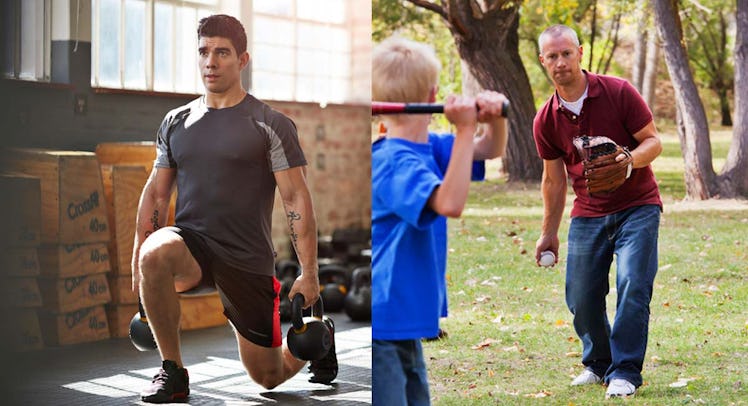The 7 “Primal Movements” You Need To Perform at the Gym
When at the gym, do as the cavemen did and nail the "primal movements."

The Cavemen figured it out. Kronck, Ugg, and the rest of their crew, whether they knew it or not, mastered the “primal movements” — the seven basic motions that transform the human body into a lean, functional machine. In those days, it helped them chase down tusked beasts and defend their families from whatever creatures came by the campfire. Today, they’ll help you increase your strength and build a body that stays stable over time.
These seven movements are as essential to you as they were to our large-browed ancestors, as they’re a basis for just about every movement we make. “When you perform these seven exercises on a regular basis, you reap benefits that are both aesthetic and functional,” says Chris Stevenson, CSCS, owner of Stevenson Fitness in Oak Park, California. “First, you have the ability and energy to do what you want with your children, without restriction. Second, you’ll be chipping away at the ‘Dad Bod’, all while encouraging your body to function properly.”
Here are the whys behind each one as well as the ways you can incorporate them into your workout, and into your daily life. Just don’t grunt that much when performing them. Kronk and Ugg wouldn’t mind, but other gym goers will.
1. Push
We don’t have to push other cavemen in the way of stampeding saber-toothed tigers anymore. But we use this motion on a daily basis. “This includes any movement that pushes weight away from the body or pushes body weight away from something,” says Stevenson. It’s a simple motion, but, per Stevenson “great for building anterior upper body strength and definition in muscles like the chest, shoulders, and triceps.”
Gym examples: Push ups, dumbbell shoulder press, incline bench press.
Perform Pushing your body up after looking for a baseball you son threw that rolled under your car; putting your toolbox back up on the top shelf.
2. Pull
“Pulling is any movement that pulls weight towards the body or pulls your body weight towards something,” says Stevenson. “It’s essential to building posterior upper body strength and definition in muscles like the back and biceps.”
Perform: Pull ups, Dumbbell rows, Lat pull down.
3. Squat
Squatting is one of those movements we probably don’t do enough outside of the gym, because bending at the back seems easier and more instinctual. But it’s essential to maintaining overall physical health. “Squatting occurs when you bend at the hips, knees, and ankles to lower your butt toward the ground, keeping your back straight, and your chest up,” says Stevenson. “Proper squatting, even in real-life, non-gym situations, is great for overall lower body strength and balance, because it strengthens the quads, hamstrings, glutes, and calves.”
Perform: Barbell squats, dumbbell squats, front squats
4. Lunge
We don’t throw many spears or rocks at wooly mammoths these days, but lunging is an essential part of maintaining lower body strength. “Lunging occurs when you step forward while bending one leg, and the other remains stationary,” Stevenson explains. “Lunges are different from squats, because you’re concentrating on one leg at a time, and you’re moving forward, strengthening the glutes, hamstrings, quads and calves.”
Perform: Barbell alternating lunges, dumbbell step-ups, side lunges
5. Bend
Once a great way to avoid swooping pterodactyls, bending is now essential to our core strength and balance. “Bending is simply when you lean forward and hinge at the hips,” says Stevenson. “The main benefits are strengthening the lower back, core, and hamstrings.”
Perform: Deadlifts, single leg romanian deadlifts, back extension
6. Twist
Twisting is something we do every day, but usually don’t realize it. “Twisting is any movement where you rotate at the torso from side-to-side,” Stevenson explains. “It’s a great exercise, because it improves overall range of motion, and improves core strength.”
Perform: Cable wood chops, seated medicine ball rotation, rotation medicine ball toss
7. Gait
“Gait refers to a combination of pulling, twisting and lunging in order to make the body walk, jog or run,” says Stevenson. “Basically, any motion that helps move the body forward. It’s a full-body exercise, perfect for overall upper body, lower body, and core strength.”
Perform: Walking, running, plyometric jumps
This article was originally published on